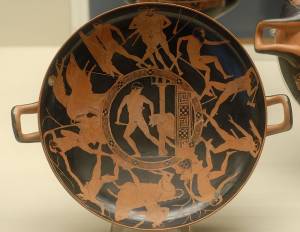Table of Contents
Theseus
Diodorus Siculus, Book 4 §59-60
<blockquote>BIRTH OF THESEUS
[4.59.1] But since we have set forth the facts concerning Heracles and his descendants, it will be appropriate in this connexion to speak of Theseus, since he emulated the Labours of Heracles. Theseus, then, was born of Aethra, the daughter of Pittheus, and Poseidon, and was reared in Troezen at the home of Pittheus, his mother’s father, and after he had found and taken up the tokens which, as the myths relate, had been placed by Aegeus beneath a certain rock, he came to Athens. And taking the road along the coast, as men say, since he emulated the high achievements of Heracles, he set out performing Labours which would bring him both approbation and fame.
THESEUS LABOURS, THE ROAD TO ATHENS
[4.59.2] The first, then, whom he slew was he who was called Corynetes, who carried a korynê, as it was called, or club which was the weapon with which he fought, and with it killed any who passed by, and the second was Sinis who made his home on the Isthmus.
[4.59.3] Sinis, it should be explained, use to bend over two pines, fasten one arm to each of them, and then suddenly release the pines, the result being that the bodies were pulled asunder by the force of the pines and the unfortunate victims met a death of great vengeance.
[4.59.4] For his third deed he slew the wild sow which ad its haunts about Crommyon, a beast which excelled in both ferocity and size and was killing many human beings. Then he punished Sceiron who made his home in the rocks of Megaris which are called after him the Sceironian Rocks. This man, namely, made it his practice to compel those who passed by to wash his feet at a precipitous place, and then, suddenly giving them a kick, he would roll them down the crags into the sea at a place called Chelonê (Turtle).
[4.59.5] And near Eleusis he slew Cercyon, who wrestled with those who passed by and killed whomever he could defeat. After this he put to death Procrustes, as he was called, who dwelt in what was known as Corydallus in Attica; this man compelled the travelers who passed by to lie down upon a bed, and if any were too long for the bed he cut of the parts of their body which protruded, while in the case of such as were too shot for it he stretched (prokrouein) their legs, this being the reason why he was given the name Procrustes.
[4.59.6] After successfully accomplishing the deeds which we have mentioned, Theseus came to Athens and by means of the tokens caused Aegeus to recognize him. Then he grappled with the Marathonian bull which Heracles in the performance of one of his Labours had brought from Crete to the Peloponnesus, and mastering the animal he brought it to Athens; this bull Aegeus received from him and sacrificed to Apollo.
[4.60.1] It remains for us now to speak of the Minotaur which was slain by Theseus, in order that we may complete our account of the deeds of Theseus. But we must revert to earlier times and set forth the facts which are interwoven with this performance, in order that the whole narrative may be clear.
Source: Diodorus Siculus. Library of History (Books III - VIII). Translated by Oldfather, C. H. Loeb Classical Library Volumes 303 and 340. Cambridge, MA, Harvard University Press; London, William Heinemann Ltd. 1935.</blockquote>
